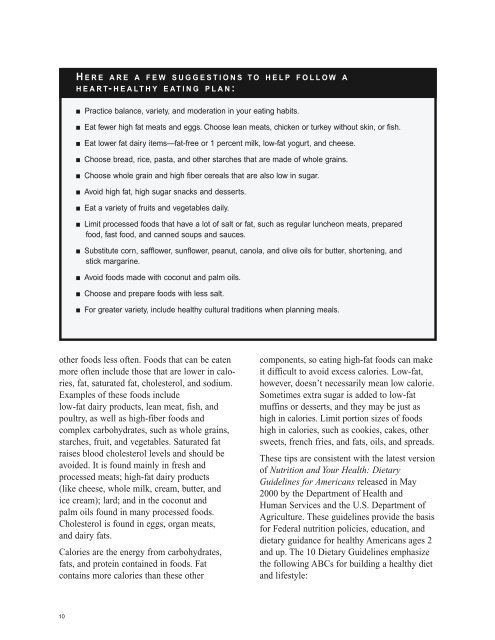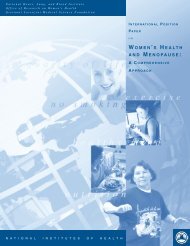HeartsNParks Community Mobilization Guide - National Heart, Lung ...
HeartsNParks Community Mobilization Guide - National Heart, Lung ...
HeartsNParks Community Mobilization Guide - National Heart, Lung ...
You also want an ePaper? Increase the reach of your titles
YUMPU automatically turns print PDFs into web optimized ePapers that Google loves.
other foods less often. Foods that can be eaten<br />
more often include those that are lower in calories,<br />
fat, saturated fat, cholesterol, and sodium.<br />
Examples of these foods include<br />
low-fat dairy products, lean meat, fish, and<br />
poultry, as well as high-fiber foods and<br />
complex carbohydrates, such as whole grains,<br />
starches, fruit, and vegetables. Saturated fat<br />
raises blood cholesterol levels and should be<br />
avoided. It is found mainly in fresh and<br />
processed meats; high-fat dairy products<br />
(like cheese, whole milk, cream, butter, and<br />
ice cream); lard; and in the coconut and<br />
palm oils found in many processed foods.<br />
Cholesterol is found in eggs, organ meats,<br />
and dairy fats.<br />
Calories are the energy from carbohydrates,<br />
fats, and protein contained in foods. Fat<br />
contains more calories than these other<br />
10<br />
H ERE ARE A FEW SUGGESTIONS TO HELP FOLLOW A<br />
HEART- HEALTHY EATING PLAN:<br />
■ Practice balance, variety, and moderation in your eating habits.<br />
■ Eat fewer high fat meats and eggs. Choose lean meats, chicken or turkey without skin, or fish.<br />
■ Eat lower fat dairy items—fat-free or 1 percent milk, low-fat yogurt, and cheese.<br />
■ Choose bread, rice, pasta, and other starches that are made of whole grains.<br />
■ Choose whole grain and high fiber cereals that are also low in sugar.<br />
■ Avoid high fat, high sugar snacks and desserts.<br />
■ Eat a variety of fruits and vegetables daily.<br />
■ Limit processed foods that have a lot of salt or fat, such as regular luncheon meats, prepared<br />
food, fast food, and canned soups and sauces.<br />
■ Substitute corn, safflower, sunflower, peanut, canola, and olive oils for butter, shortening, and<br />
stick margarine.<br />
■ Avoid foods made with coconut and palm oils.<br />
■ Choose and prepare foods with less salt.<br />
■ For greater variety, include healthy cultural traditions when planning meals.<br />
components, so eating high-fat foods can make<br />
it difficult to avoid excess calories. Low-fat,<br />
however, doesn’t necessarily mean low calorie.<br />
Sometimes extra sugar is added to low-fat<br />
muffins or desserts, and they may be just as<br />
high in calories. Limit portion sizes of foods<br />
high in calories, such as cookies, cakes, other<br />
sweets, french fries, and fats, oils, and spreads.<br />
These tips are consistent with the latest version<br />
of Nutrition and Your Health: Dietary<br />
<strong>Guide</strong>lines for Americans released in May<br />
2000 by the Department of Health and<br />
Human Services and the U.S. Department of<br />
Agriculture. These guidelines provide the basis<br />
for Federal nutrition policies, education, and<br />
dietary guidance for healthy Americans ages 2<br />
and up. The 10 Dietary <strong>Guide</strong>lines emphasize<br />
the following ABCs for building a healthy diet<br />
and lifestyle:
















